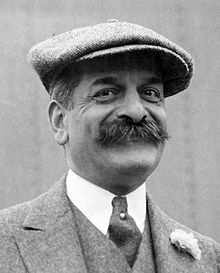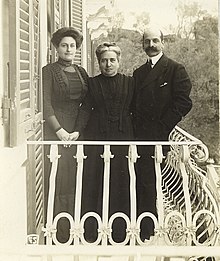Felix M. Warburg
Felix Moritz Warburg (born January 14, 1871 in Hamburg , † September 20, 1937 in New York ) was a German-American banker and patron from the Warburg banking dynasty of Hamburg . His former home in Central Park on the Upper East Side in New York City now houses the Jewish Museum .
Life
Felix M. Warburg was the fourth of five sons in the family line of the Hamburg - Rotherbaum based middle -Warburgs born Moritz M. Warburg and his wife Charlotte Esther Warburg. His father managed the family-owned Hamburg private bank MM Warburg & CO -Bank in the third generation. Like his brothers Max M. Warburg (1846–1946), Paul M. Warburg (1868–1932) and Fritz M. Warburg (1879–1964), Felix also became an internationally important banker. His eldest brother Aby M. Warburg (1866–1929) worked as an art historian and was a. a. Founder of the renowned Warburg Institute in London .

In 1894 Felix M. Warburg emigrated to the United States and became a partner at the leading Wall Street bank Kuhn, Loeb & Co. in New York City . In 1895, Felix M. Warburg married Frieda Schiff (1876-1958), the daughter of his senior partner Jacob Schiff from the Kuhn, Loeb & Co. bank. The couple belonged to the reform synagogue Temple Emanu El and had a daughter and four sons: Felix M. Warburgs only daughter Carola Warburg Rothschild (1896–1987) married the entrepreneur Walter N. Rothschild from the Rothschild dynasty . The eldest son Frederick M. Warburg (1897–1973) became an investment banker and, like his father, a partner at Kuhn, Loeb & Co. in New York. Paul Felix Solomon Warburg (1904–1965) developed highly successful fundraising methods for the Federation of Jewish Philanthropies of Greater New York and was an active board member of numerous Jewish associations in New York City. Edward Mortimer Morris Warburg (1908-1992) was an art lover, co-founder of MoMa , founding father of American ballet , co-founder of the Harvard Society for Contempory Arts , vice-chairman of the Joint Distribution Committee and US chairman of the United Jewish Appeal . Gerald Felix Warburg (1902–1971) was a successful cellist of international stature.
Through his interests and connections, Felix Warburg, who received American citizenship in 1907 , became a key figure in the German-Jewish elite in the American Jewish community of the early 20th century. He was a leading member of the American Jewish Joint Distribution Committee , the support of distressed Jews in Europe after the end of itself the First World War had put to the task. As early as 1919 he undertook an exploratory trip through Europe and put the results together in a report in which, as the New York Times wrote, he stated that the Jewish population in Eastern Europe suffered most from the consequences of the war.
In 1925 he became a member of the Board of Governors of the newly founded Hebrew University of Jerusalem together with Harry Sacher , Chaim Weizmann , Albert Einstein , Martin Buber and Sigmund Freud . He also served on the supervisory bodies of Columbia University and the Jewish Seminary in New York and the Fogg Art Museum at Harvard University , whose main hall was named after him in 1931. A room in the American Museum of Natural History was also named after him, the Felix M. Warburg Memorial Hall of Agriculture , now the Warburg Hall of New York State Environment. His extensive collection of European drawings and prints was later given to the Art Center of Vassar College . His personal and business written estate went to the American Jewish Archives in Cincinnati, Ohio.
In recognition of his humanitarian work, a Jewish settlement in the then Mandate Palestine was named after him in 1939, Kfar Warburg .
Warburg House

In 1908, Felix and Frieda Warburg had the architect CPH Gilbert build a representative six-story house in the neo-Gothic style on the corner of Fifth Avenue and East 92nd Street. After Felix's death, Frieda Schiff Warburg donated the building as the future seat of the Jewish Museum in January 1944. It opened here in 1947 and is still housed in the building in the middle of Museum Mile, which was expanded in 1963 and 1993 .
literature
- Ron Chernow : The Warburgs - A Family Odyssey . Siedler-Verlag , Munich, 1994, ISBN 3-886805-21-2
- E. Rosenbaum, AJ Sherman: The banking house MMWarburg & Co. 1798–1938 . Christians, Hamburg 1976, ISBN 3-7672-0420-7 .
- Yehuda Bauer: My Brother's Keeper. A History of the American Jewish Joint Distribution Committee 1929-1939. Philadelphia: Jewish Publication Society of America 1974 ISBN 0-8276-0048-8 .
Web links
- Felix M. Warburg Papers in The Jacob Rader Marcus Center of the American Jewish Archives (biographical note and inventory overview, English)
- Felix M. Warburg in the database of Find a Grave (English)
- Felix M. Warburg Collection at Harvard Business School
- Newspaper article about Felix M. Warburg in the 20th century press kit of the ZBW - Leibniz Information Center for Economics .
Individual evidence
- ↑ Alden Whitman: Frederick M. Warburg, 75, Dies; Investment banker, Sportsman. The New York Times, July 11, 1973
- ^ Jewish Telegraphic Agency: Paul Felix Warburg Dead; What 61; Funeral Services Tomorrow. JTA, October 11, 1965
- ↑ Eric Pace: Edward Warburg, Philanthropist And Patron of the Arts, Dies at 84 The New York Times, September 22, 1992
- ^ The New York Times: Gerald F. Warburg, 69, Is Dead; Cellist and a Patron of the Arts. The New York Times, February 15, 1971
- ^ Warburg was a key figure in the German-Jewish elite of the early 20th century American Jewish community. Felix M. Warburg Papers .
- ^ Tells sad plight of Jews New Tork Times, November 12, 1919
- ^ Bulletin of the Fogg Museum of Art November 1937
- ↑ American Museum of Natural History ( Memento of the original from November 23, 2010 in the Internet Archive ) Info: The archive link was automatically inserted and has not yet been checked. Please check the original and archive link according to the instructions and then remove this notice.
- ^ The Felix M. Warburg Print Collection
| personal data | |
|---|---|
| SURNAME | Warburg, Felix M. |
| ALTERNATIVE NAMES | Warburg, Felix Moritz (full name) |
| BRIEF DESCRIPTION | German-American banker and patron |
| DATE OF BIRTH | January 14, 1871 |
| PLACE OF BIRTH | Hamburg |
| DATE OF DEATH | September 20, 1937 |
| Place of death | New York City |

